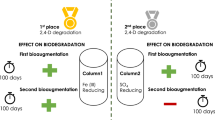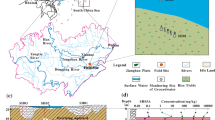Abstract
Pathways of ammonium (NH4 +) removal were investigated using the stable isotope approach in constructed wetlands (CWs). We investigated and compared several types of CWs: planted horizontal subsurface flow (HSSF), unplanted HSSF, and floating plant root mat (FPRM), including spatial and seasonal variations. Plant presence was the key factor influencing efficiency of NH4 + removal in all CWs, what was illustrated by lower NH4 +-N removal by the unplanted HSSF CW in comparison with planted CWs. No statistically significant differences in NH4 + removal efficiencies between seasons were detected. Even though plant uptake accounted for 32–100 % of NH4 + removal during spring and summer in planted CWs, throughout the year, most of NH4 + was removed via simultaneous nitrification-denitrification, what was clearly shown by linear increase of δ15N-NH4 + with decrease of loads along the flow path and absence of nitrate (NO3 −) accumulation. Average yearly enrichment factor for nitrification was −7.9 ‰ for planted HSSF CW and −5.8 ‰ for FPRM. Lack of enrichment for δ15N-NO3 − implied that other processes, such as nitrification and mineralization were superimposed on denitrification and makes the stable isotope approach unsuitable for the estimation of denitrification in the systems obtaining NH4 + rich inflow water.







Similar content being viewed by others
References
Adamsen FJ, Reeder JD (1983) A comparison of diffusion and distillation methods for preparing samples for N-15 analyses. Soil Sci Soc Am J 47:612–613
Akratos CS, Tsihrintzis VA (2007) Effect of temperature, HRT, vegetation and porous media on removal efficiency of pilot-scale horizontal subsurface flow constructed wetlands. Ecol Eng 29:173–191
Armstrong J, Armstrong W (1990) Light-enhanced convective throughflow increases oxygenation in rhizomes and rhizosphere of Phragmites australis. New Phytol 114:121–128
Bernot M, Bernot R, Morris J (2009) Nutrient cycling relative to δ15N and δ13C natural abundance in a coastal wetland with long-term nutrient additions. Aquat Ecol 43:803–813
Brix H (1990) Gas-exchange through the soil atmosphere interphase and through dead culms of Phragmites australis in a constructed reed bed receiving domestic sewage. Water Res 24:259–266
Brix H (1997) Do macrophytes play a role in constructed treatment wetlands? Water Sci Technol 35:11–17
Casciotti KL, Sigman DM, Ward BB (2003) Linking diversity and stable isotope fractionation in ammonia-oxidizing bacteria. Geomicrobiol J 20:335–353
Castine SA, Erler DV, Trott LA, Paul NA, de Nys R, Eyre BD (2012) Denitrification and anammox in tropical aquaculture settlement ponds: an isotope tracer approach for evaluating N-2 production. PLoS ONE 7
Fukuhara H, Nemoto F, Takeuchi Y, Toda N (2007) Nitrate dynamics in a reed belt of a shallow sand dune lake in Japan: analysis of nitrate retention using stable nitrogen isotope ratios. Hydrobiologia 584:49–58
Garcia J, Rousseau DPL, MoratÓ J, Lesage ELS, Matamoros V, Bayona JM (2010) Contaminant removal processes in subsurface-flow constructed wetlands: a review. Crit Rev Environ Sci Technol 40:561–661
Granger J, Sigman DM, Lehmann MF, Tortell PD (2008) Nitrogen and oxygen isotope fractionation during dissimilatory nitrate reduction by denitrifying bacteria. Limnol Oceanogr 53:2533–2545
Gries C, Kappen L, Losch R (1990) Mechanism of flood tolerance in reed. Phragmites australis. New Phytol 114:589–593
Groffman PM, Altabet MA, Bohlke JK, Butterbach-Bahl K, David MB, Firestone MK, Giblin AE, Kana TM, Nielsen LP, Voytek MA (2006) Methods for measuring denitrification: diverse approaches to a difficult problem. Ecol Appl 16:2091–2122
Harrington R, McInnes R (2009) Integrated constructed wetlands (ICW) for livestock wastewater management. Bioresour Technol 100:5498–5505
Hauck RD (1973) Nitrogen tracers in nitrogen cycle studies—past use and future needs1. J Environ Qual 2:317–327
Havens KE, Hauxwell J, Tyler AC, Thomas S, McGlathery KJ, Cebrian J, Valiela I, Steinman AD, Hwang S-J (2001) Complex interactions between autotrophs in shallow marine and freshwater ecosystems: implications for community responses to nutrient stress. Environ Pollut 113:95–107
Ip YK, Chew SF, Randall DJ (2001) Ammonia toxicity, tolerance, and excretion. In: Patricia W, Paul A (Eds), Fish Physiology. Academic Press, pp. 109–148
Kadlec RH (2000) The inadequacy of first-order treatment wetland models. Ecol Eng 15:105–119
Kadlec RH, Wallace SD (2008) Treatment wetlands, 2nd Edition. CRC Press
Kendall C, McDonnell JJ (1999) Isotope tracers in catchment hydrology. Elsevier
Knoeller K, Vogt C, Richnow HH, Weise SM (2006) Sulfur and oxygen isotope fractionation during benzene, toluene, ethyl benzene, and xylene degradation by sulfate-reducing bacteria. Environ Sci Technol 40:3879–3885
Kritee K, Sigman DM, Granger J, Ward BB, Jayakumar A, Deutsch C (2012) Reduced isotope fractionation by denitrification under conditions relevant to the ocean. Geochim Cosmochim Acta 92:243–259
Lee CG, Fletcher TD, Sun GZ (2009) Nitrogen removal in constructed wetland systems. Eng Life Sci 9:11–22
Lund LJ, Horne AJ, Williams AE (1999) Estimating denitrification in a large constructed wetland using stable nitrogen isotope ratios. Ecol Eng 14:67–76
Lund LJ, Horne AJ, Williams AE (2000) Estimating denitrification in a large constructed wetland using stable nitrogen isotope ratios. Ecol Eng 14:67–76
Mangimbulude JC, van Straalen NM, Röling WFM (2012) Microbial nitrogen transformation potential in surface run-off leachate from a tropical landfill. Waste Manag 32:77–87
Martienssen M, Fabritius H, Kukla S, Balcke GU, Hasselwander E, Schirmer M (2006) Determination of naturally occurring MTBE biodegradation by analysing metabolites and biodegradation by-products. J Contam Hydrol 87:37–53
Martin JF, Reddy KR (1997) Interaction and spatial distribution of wetland nitrogen processes. Ecol Model 105:1–21
McIlvin MR, Casciotti KL (2011) Technical updates to the bacterial method for nitrate isotopic analyses. Anal Chem 83:1850–1856
Molle P, Prost-Boucle S, Lienard A (2008) Potential for total nitrogen removal by combining vertical flow and horizontal flow constructed wetlands: a full-scale experiment study. Ecol Eng 34:23–29
Reinhardt M, Muller B, Gachter R, Wehrli B (2006) Nitrogen removal in a small constructed wetland: an isotope mass balance approach. Environ Sci Technol 40:3313–3319
Robinson D (2001) Delta N-15 as an integrator of the nitrogen cycle. Trends Ecol Evol 16:153–162
Saez-Plaza P, Navas MJ, Wybraniec S, Michalowski T, Asuero AG (2013) An overview of the Kjeldahl method of nitrogen determination. Part II. Sample preparation, working scale, instrumental finish, and quality control. Crit Rev Anal Chem 43:224–272
Seeger EM, Kuschk P, Fazekas H, Grathwohl P, Kaestner M (2011) Bioremediation of benzene-, MTBE- and ammonia-contaminated groundwater with pilot-scale constructed wetlands. Environ Pollut 159:3769–3776
Siljeg M, Foglar L, Kukucka M (2010) The ground water ammonium sorption onto Croatian and Serbian clinoptilolite. J Hazard Mater 178:572–577
Singleton MJ, Esser BK, Moran JE, Hudson GB, McNab WW, Harter T (2007) Saturated zone denitrification: potential for natural attenuation of nitrate contamination in shallow groundwater under dairy operations. Environ Sci Technol 41:759–765
Sovik AK, Morkved PT (2007) Nitrogen isotope fractionation as a tool for determining denitrification in constructed wetlands. Water Sci Technol 56:167–173
Sovik AK, Morkved PT (2008) Use of stable nitrogen isotope fractionation to estimate denitrification in small constructed wetlands treating agricultural runoff. Sci Total Environ 392:157–165
Spoelstra J, Schiff SL, Semkin RG, Jeffries DS, Elgood RJ (2010) Nitrate attenuation in a small temperate wetland following forest harvest. Ecol Manag 259:2333–2341
Vymazal J (2007) Removal of nutrients in various types of constructed wetlands. Sci Total Environ 380:48–65
Wankel SD, Kendall C, Paytan A (2009) Using nitrate dual isotopic composition (delta N-15 and delta O-18) as a tool for exploring sources and cycling of nitrate in an estuarine system: Elkhorn Slough, California. J. Geophys. Res.-Biogeosci. 114
Wiessner A, Kappelmeyer U, Kaestner M, Schultze-Nobre L, Kuschk P (2013) Response of ammonium removal to growth and transpiration of Juncus effusus during the treatment of artificial sewage in laboratory-scale wetlands. Water Res 47:4265–4273
Zhang L, Altabet MA (2008) Amino-group-specific natural abundance nitrogen isotope ratio analysis in amino acids. Rapid Commun Mass Spectrom 22:559–566
Zhu GB, Wang SY, Feng XJ, Fan GN, Jetten MSM, Yin CQ (2011) Anammox bacterial abundance, biodiversity and activity in a constructed wetland. Environ Sci Technol 45:9951–9958
Acknowledgments
This research was completed within the framework of the Marie Curie Initial Training Network ADVOCATE—Advancing sustainable in situ remediation for contaminated land and groundwater, funded by the European Commission, Marie Curie Actions Project No. 265063, SAFIRA project and the Helmholtz Interdisciplinary Graduate School for Environmental Research (HIGRADE). We are also grateful to Martina Neuber of the stable isotope laboratory Halle/Salle for conducting isotope analyses of the samples. Thank is also addressed to Dang Thi Kim Anh for her valuable assistance in the laboratory and field.
Author information
Authors and Affiliations
Corresponding author
Additional information
Responsible editor: Robert Duran
Rights and permissions
About this article
Cite this article
Coban, O., Kuschk, P., Wells, N.S. et al. Microbial nitrogen transformation in constructed wetlands treating contaminated groundwater. Environ Sci Pollut Res 22, 12829–12839 (2015). https://doi.org/10.1007/s11356-014-3575-3
Received:
Accepted:
Published:
Issue Date:
DOI: https://doi.org/10.1007/s11356-014-3575-3




